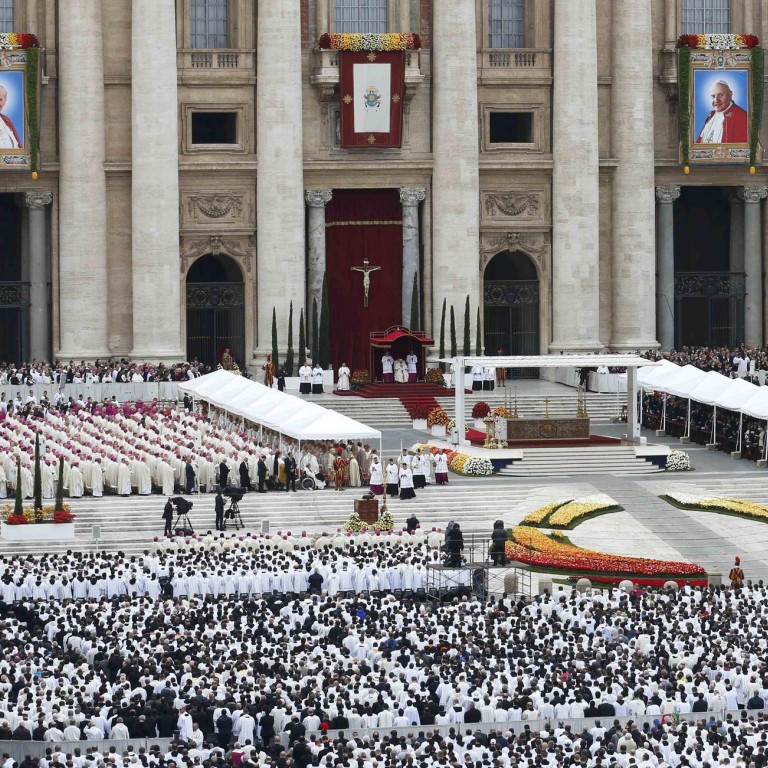
Two popes canonised at single Vatican ceremony attended by Pope Francis and predecessor Benedict
Francis and Benedict attend ceremony to make John XXIII and John Paul II saints, the first time two ex-pontiffs are canonised at the same time
One helped revolutionise the church, becoming an enduring icon among progressive Roman Catholics who view religion as a vehicle for justice and peace.
The other figured in a societal revolution outside the church, earning the adulation of conservatives by battling communism and contributing to the downfall of the Soviet Union.

Cheers and applause rang out across St Peter's Square after the historic double canonisation as many in the crowd fixed their gaze on huge tapestries of the two popes on the facade of the basilica behind Francis.
The mass was also attended by former pope Benedict, who last year became the first pontiff in six centuries to step down. Never before have a reigning pope and a retired pope celebrated mass together in public, much less at an event honouring two of their most famous predecessors.
"We declare and define Blessed John XXIII and John Paul II to be saints and we enrol them among the saints, decreeing that they are to be venerated as such by the whole church," Francis said in his formal proclamation in Latin about 30 minutes into the solemn service.
Francis took a deep breath and paused for a moment before reciting the saint-making formula in Latin at the start of the ceremony, as if moved by the history he was about to make in canonising two popes at once.
Applause broke out from a crowd that stretched from St Peter's Square to the Tiber River and beyond.
"This is such a historic moment," marvelled the Reverend Victor Perez, who brought a group from the John Paul High School in Houston, Texas, and waited for nearly 12 hours to get near St Peter's. "John Paul was so impactful on the church. He completed the work of Vatican II. Today honours the last 50 years of what God has done in the church."
In John Paul's native Poland, bells rang out as soon as Francis pronounced the two men saints.
"He changed Poland and he changed us with his teaching and with his visits here," an emotional Maria Jurek said as she watched the proceedings on giant TV screens at a sanctuary dedicated to John Paul in Krakow.

Commentators defined the event as a "four-pope day". The Vatican said 800,000 people followed the event in Rome, including 500,000 in and around St Peter's Square.
John XXIII, who reigned from 1958 to 1963 and called the modernising Second Vatican Council, and John Paul II, who reigned for nearly 27 years, played a leading role on the world stage. The two new saints are buried in crypts in St Peter's Basilica.
John, an Italian often known as the "Good Pope" because of his friendly, open personality, died before the Second Vatican Council ended its work in 1965, but his initiative set off one of the greatest upheavals in church teaching in modern times.
The council ended the use of Latin at mass, brought in the use of modern music and opened the way for challenges to Vatican authority, which alienated some traditionalists.
John Paul was widely credited with helping to bring down communist rule in eastern Europe and hastening the end of the cold war. He continued many of the reforms but tightened central control, condemned theological renegades and preached a stricter line on social issues.
There has also been criticism that John Paul II, who died just nine years ago, was canonised too quickly.
The path to sainthood
The process that can lead to sainthood, known as a "cause", cannot usually start until five years after a person's death. In some cases, this waiting period can be waived by a pope.
Pope John Paul waived the five-year period for Mother Teresa of Calcutta, who died in 1997, and Pope Benedict waived it for the sainthood cause of Pope John Paul, who died in 2005.
In the early years of the church, a saint could be declared such by acclamation by the people or by cardinals or by papal decree. Today, the Vatican department that studies sainthood causes is known as the Congregation for the Causes of Saints.
After the congregation accepts the name of a person to be considered for sainthood, historical and theological commissions in the congregation study the person's life, read his or her writings and interview people who knew the person. At this point, in order for the procedure to continue, a miracle is needed.
A miracle is usually a medically inexplicable healing. A medical commission appointed by the Vatican determines if there was any medical explanation for the healing or not.
If a miracle is determined, the person can be "beatified" and is given the title "Blessed". John XXIII was beatified in 2000 and John Paul in 2011.
A second, distinct miracle must take place after the beatification in order to proceed to sainthood. Reuters
